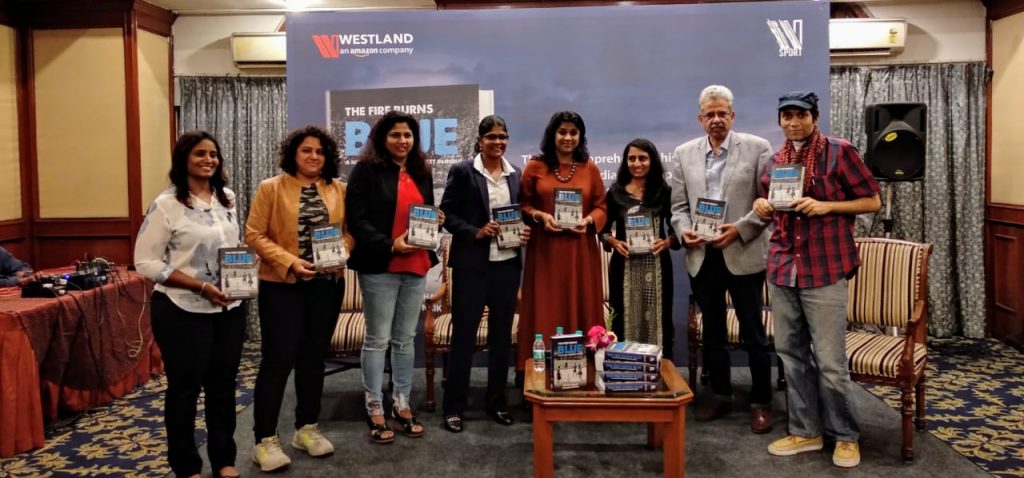Mamatha Maben urges BCCI to work on development of women’s cricket at grassroots level

SportsCafe
Former Indian women’s skipper Mamatha Maben has stated that the standard of women’s cricket in India will develop only if the grassroots level gets more attention. Sidhanta Patnaik, the co-author of “Fire Burns Blue”, has added that media should also give more attention to women’s cricket.
It was an engaging discussion session on a topic that very few talk about. Women’s cricket, of course, got the mileage after the 2017 World Cup campaign, where India reached the final, but the former women’s cricketers who joined the dots in Indian cricketing landscape still remained an unknown entity in the big Indian cricketing colosseum. So, when two writers, who have passionately followed the sport in the country, published a history book on the topic, it created a lot of
On the launch ceremony of the book in Bangalore on Wednesday, which was attended by Pramila Bhatt and Mamatha Maben, two former Indian skippers, there was a detailed discussion on how the women’s cricket can go beyond the riches if it gets proper attention from every stakeholder involved. During the conversation, Maben struck the chord when she advocated for the development of grassroots cricket and was of the opinion that it would pay back in future if proper investment being made.
“A lot has changed at least for the cream. When the cream is concerned, they are always playing but there is still a lot to be done at the domestic level. Our Karnataka state girls practice very hard through the year, but they get to play eight matches in a year and a few more if they qualify. But the cream has no such issue. What about others? I think there has to be more investment there and in the long term it is going to pay back,” Maben said.
Keshav, who had the first-hand experience of talking to many domestic cricketers struggling to pay for their kits and gym bills, was quite emotional about their lifestyle and asked for an equal pay system as of their male counterparts.
“Equal pay. When you ask the cricketers the difference of pay between a male and a female is not much of an issue. It doesn’t matter to them, but if you are not putting the investment in the grassroots, it does not matter. What is almost non-negotiable now is state contracts. Other countries have shown the way. This year they have increased the pay a bit, but as of last year who did not play age-group around 35000 per year, but she still has to invest in gym, diet. There are also stories of players saving up their DA. You need to put them in a pathway on what they can do after cricket. No Indian player is in the shortlist of coaches, but there has been no pathway for them,” Keshav said.
Marketing is an aspect that cricket has come on to embrace since the World Cricket Series in 1977. The will and strong zeal of Jagmohan Dalmiya played a huge role in CAB striking a big TV deal with TWI (Trans World International) to telecast the Hero Cup in 1993 and riding on the wave of the economic
While the men’s cricket was the driving force behind it, the huge surplus could have been used for the women’s cricket in a professional manner in which BCCI has failed terribly at, unlike their Australian and English counterparts, after taking over from Women’s Cricket Association of India in the mid-2000s. Both Bhatt and Maben agreed to the point that a lot can be done, especially because it has already risen to public consciousness.
“I think much more can be done. It can be marketed much better. Though BCCI is doing so much, I thought immediately after the World Cup last year it was such a huge platform. You cannot imagine the kind of boost women’s cricket got not only in
“Eventually when we had the T20I series it was in the morning, and that too in a
Maben, who played 40 women's one-day internationals, including the 1993 Women's Cricket World Cup in England, further went on to state that BCCI needs a visionary for the women's cricket and hand over the project to him with a clear-cut plan for the future.
“We need a visionary. If we can have a visionary at the helm and say women’s cricket is your baby and you develop it over five years. You take a couple of steps forward. What mistake we are doing is we always compare to men’s cricket. They are somewhere else. Where we are, from there take five feet up no. That much only we are asking. For that, we need a visionary.”
While Bhatt and Maben were quite eloquent in putting forward their perspectives regarding where women’s cricket stands at the moment, the co-authors of the book, Patnaik and Keshav, focused more on the issue from a journalistic standpoint, asking the media to give more intrusive and dedicated coverage for the women’s cricket in India. Patnaik was of the opinion that online media should focus more on nurturing a product so that it would become a selling one in due course of time, asking the question of how many analytical copies journalists are churning out regarding the women’s cricket.
“Mithali Raj is a legend in every sense. In 19-20 years her batting has never been dissected except for one interview Karunya and I did last year in Colombo. Can this happen to Sachin Tendulkar, going 20 years without his batting being
The session was moderated by senior cricket journalist Suresh Menon and was also attended by former Indian cricketers Smitha Harikrishna and Manju Nadgoda, among others. Menon, in his introduction of the writers, mentioned that the “Fire Burns Blue” was the “the finest book on the history of cricket written in India - men or women.”
Cricket FootBall Kabaddi
Basketball Hockey
SportsCafe
